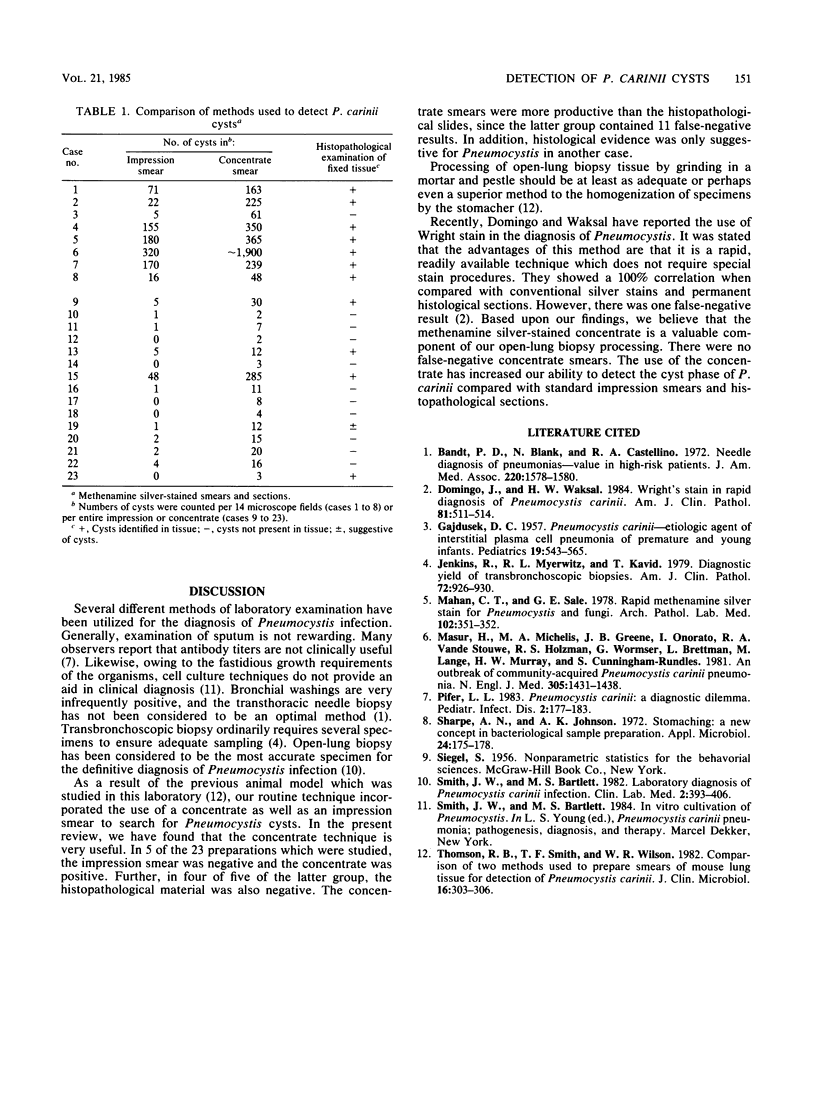Abstract
Methenamine silver stain was used to compare the number of cysts of Pneumocystis carinii contained in lung concentrate smears of homogenized lung tissue with the number in impression smears. Results were also compared with histopathological examination of methenamine silver-stained paraffin-embedded sections. Of slides from 23 preparations, a greater number of cysts were contained in concentrate smears than in impressions (P less than 0.001). In four preparations, cysts were noted in concentrate smears only. All concentrate smears were positive, whereas 11 of the 23 histopathological sections were negative (P less than 0.01). The ability to detect the cyst phase of P. carinii in lung tissue is enhanced by the use of concentrate smears.
Full text
PDF

Selected References
These references are in PubMed. This may not be the complete list of references from this article.
- Bandt P. D., Blank N., Castellino R. A. Needle diagnosis of pneumonitis. Value in high-risk patients. JAMA. 1972 Jun 19;220(12):1578–1580. [PubMed] [Google Scholar]
- Domingo J., Waksal H. W. Wright's stain in rapid diagnosis of Pneumocystis carinii. Am J Clin Pathol. 1984 Apr;81(4):511–514. doi: 10.1093/ajcp/81.4.511. [DOI] [PubMed] [Google Scholar]
- GAJDUSEK D. C. Pneumocystis carinii; etiologic agent of interstitial plasma cell pneumonia of premature and young infants. Pediatrics. 1957 Apr;19(4 Pt 1):543–565. [PubMed] [Google Scholar]
- Jenkins R., Myerowitz R. L., Kavic T., Slasky S. Diagnostic yield of transbronchoscopic biopsies. Am J Clin Pathol. 1979 Dec;72(6):926–930. doi: 10.1093/ajcp/72.6.926. [DOI] [PubMed] [Google Scholar]
- Mahan C. T., Sale G. E. Rapid methenamine silver stain for Pneumocystis and fungi. Arch Pathol Lab Med. 1978 Jul;102(7):351–352. [PubMed] [Google Scholar]
- Masur H., Michelis M. A., Greene J. B., Onorato I., Stouwe R. A., Holzman R. S., Wormser G., Brettman L., Lange M., Murray H. W. An outbreak of community-acquired Pneumocystis carinii pneumonia: initial manifestation of cellular immune dysfunction. N Engl J Med. 1981 Dec 10;305(24):1431–1438. doi: 10.1056/NEJM198112103052402. [DOI] [PubMed] [Google Scholar]
- Pifer L. L. Pneumocystis carinii: a diagnostic dilemma. Pediatr Infect Dis. 1983 May-Jun;2(3):177–183. doi: 10.1097/00006454-198305000-00001. [DOI] [PubMed] [Google Scholar]
- Sharpe A. N., Jackson A. K. Stomaching: a new concept in bacteriological sample preparation. Appl Microbiol. 1972 Aug;24(2):175–178. doi: 10.1128/am.24.2.175-178.1972. [DOI] [PMC free article] [PubMed] [Google Scholar]
- Smith J. W., Bartlett M. S. Laboratory diagnosis of Pneumocystis carinii infection. Clin Lab Med. 1982 Jun;2(2):393–406. [PubMed] [Google Scholar]
- Thomson R. B., Jr, Smith T. F., Wilson W. R. Comparison of two methods used to prepare smears of mouse lung tissue for detection of Pneumocystis carinii. J Clin Microbiol. 1982 Aug;16(2):303–306. doi: 10.1128/jcm.16.2.303-306.1982. [DOI] [PMC free article] [PubMed] [Google Scholar]


